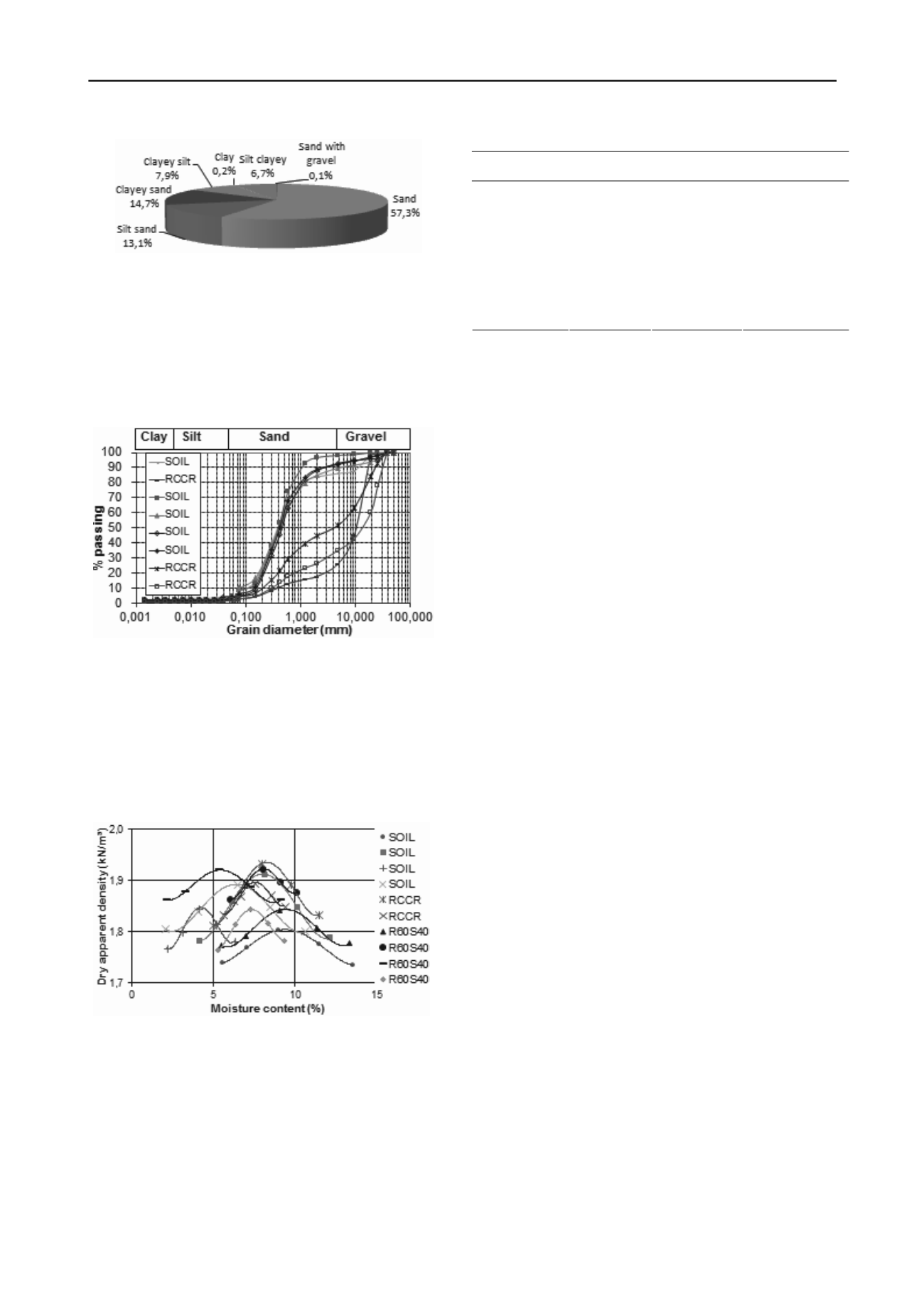
3201
Technical Committee 307 /
Comité technique 307
Figure 2 – Prediction of the excavated soil by piles through assays
.
5.3 Granulometry
Figure 3 shows the granulometric curve of soil samples and of
RRCC. It is observed that the RCCR is classified as gravel with
thick and medium-sized sand. On the other hand, the soil is
medium-sized and thin sand, which coincides with the prior
prediction made by the assays.
Figure 3 – Grain size curve of soil and of RRCC.
5.4 Compaction curves
Figure 4 shows some compaction tests with intermediate
energy. It is observed that the optimum moisture varies between
4.1 and 9.1%, which are typical values for granular soils. It is
also observed that the mixture soil + RRCC presented higher
densities than the materials isolated, probably due to the fact
that a higher degree of the group was reached.
Figure 4 – Compaction Curves for soil, RRCC and mixture.
5.5 California Bearing Ratio (CBR)
Table 3 shows the CBR values obtained for the soil, RRCC and
mixture of 60% RRCC and 40% soil (R60S40). The average
values were equal to 39, 189 and 115%, respectively. The
expansion values ranged from 0 to 0.2%.
Table 3 – Summary of the CBR values.
Material
CBR (%)
Avarage
Value (%)
Variance
Coefficient (%)
10
76
19
Soil
51
39
78
191
RCCR
188
189
1
84
108
130
R60S40
138
115
21
Regarding the NBR 15.116/04, for the possibility to use
recycled material in the sub-base layers and pavement bases,
CBR minimum is of 20% and 60%, respectively, implying that
all mixtures have adapted to the requirements of the standard.
5.6 Shape Index
As the shape index approaches only the coarse aggregate with
maximum characteristic dimension superior to 9.5 mm, only the
RRCC samples were assayed. According to NBR 7809:1983,
the maximum limit in the relation length/thickness is 3.0. This
condition was met in both samples.
5.7 “Los Angeles” Abrasion
Just as in shape index, the "Los Angeles" abrasion test refers
only to the coarse aggregate. For the two RRCC samples, the
values were equal to 26.8 and 26.3% of depreciation, which are
below the maximum limit of 50% set in the standard.
5.8 Sulphate levels
The maximum level of sulphate in relation to the mass of the
recycled aggregate is 2%, according to NBR 15.116:2004. The
values obtained in the assays of the soil and RRCC ranged
between 0.04 and 0.09%, in other words, they were below the
maximum limit set in the standard.
5.9 Technical Feasibility for using CDW in Paving Projects
Table 4 summarizes the results of some samples of soil, RRCC
and the mixture soil-RRCC, comparing the values with the
recommendation of NBR 15.116:2004. It was observed that
only the soil did not meet the requirements for the use in paving
layers. However, both the isolated RRCC as well as mixed with
soil from the excavation of piles, meet all the criteria of the
standard.
5.10 Economic feasibility of the use of CDW in paving projects
For the study of the economic feasibility of using CDW in
paving layers in the project, an inquiry of the unitary cost of the
acquisition of the aggregates specified in the paving project was
initially performed, whose values are shown in Table 5. The
costs of implementing the layers were not considered in the
comparison, as it would be the same with the use of natural
aggregates or CDW.
Table 6 shows the costs for the disposal at two sites licensed
by the environmental agencies, which is an inert landfill or a
processing plant for CDW. Both are located in the Metropolitan
area of Recife.


